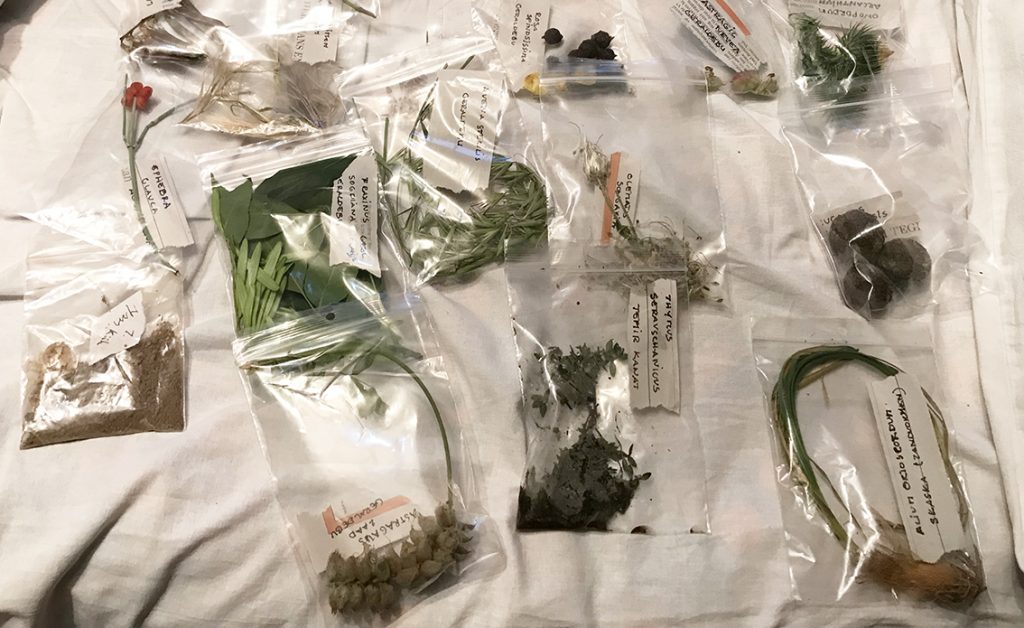Kaart 7. – de natuur als schatkist for english see below
Je gebruikt alles wat de natuur je geeft maar je neemt nooit te veel. Alles moet in balans blijven. De natuur is in harmonie en elke plant is van waarde. Mos is goed voor de nieren, verse paardenmelk bevat alle soorten vitaminen en is heilzaam bij longziekten, edelweiss reinigt het bloed en de maag, goudwortel (Rhodiola kirilowii) verhoogt de weerstand van het lichaam tijdens de koude winters. Bij zoutgebrek kun je zoutkruid (Salsola oppositifolia) vinden in uitgedroogde rivierbeddingen en van zwarte bessen (Ribes nigrum) maak je thee.
Al deze verhalen hoorde ik tijdens het onderzoek in Kirgistan van de botanici en bewoners. Hoogleraar etnobotanie Tinde van Andel schrijft over het belang van lokale kennis van nuttige planten en gewassen. Zie voor meer over planten in tijden van honger, vegetatie met gif en planten voor sjamanen bij verhalen (bij volkswijsheden)
Elk jaar als de sneeuw gesmolten is, komen er mensen naar de zomerweiden om wortels, kruiden en mos te verzamelen. “Gras is de eeuwige gift van de aarde”, zegt Tanabaj in Afscheid van Goelsary (1970) in het boek van de Kirgizische schrijver Tsjingiz Ajtmatov.
Kirgistan heeft de oudste fruitbossen op aarde: met een grote soortenrijkdom aan walnoten, peren, appels, kersen, pruimen, abrikozen, amandelen, hazelnoten en pistachenoten. Alle fruitbomen vinden hier hun oorsprong. De oerappel komt hiervandaan (Alma-Ata bekent rijk aan appels). Daarom noemen deze streek ook ‘genenbank van internationaal belang’. (Zie ook de inleidende blog Onderzoek in Kirgistan)
De uitzonderlijk hoge biodiversiteit van Kirgistan heeft te maken met de aanwezigheid van veel verschillende ecosystemen. In het westen bevinden zich vochtige vegetatiezones; in de hoger gelegen streken vind je montane vegetatiezones.
In de herfst trekt men met de hele familie en het vee de fruitbossen in om kruiden, noten en fruit te verzamelen. Gedroogde bessen, appels, noten en honing zijn belangrijke voedingsmiddelen om de lange winter door te komen. Noten, kruiden en fruit worden ook verhandeld. De bossen komen daarmee onder druk te staan. Jonge scheuten van bomen worden voortijdig opgegeten door het vee. De bossen behoren tot de ‘commons’ waar iedereen zijn deel van neemt. Dit werkte goed maar nu zorgen de invasies een bedreiging van de soortenrijkdom en voor verjonging van de bossen. Zie ook de BBC film over de walnootbossen.
The Sovjets maakten rubber uit een van een bepaalde soort paardenbloemen (Taraxacum kok-saghyz) die latex bevatten. Veel kolgozen werden verplicht deze soort paardenbloemen te planten. De Wageningen Universiteit experimenteert nu weer met deze paardenbloemen voor het maken van fietsbanden omdat de Braziliaanse rubberboom wereldwijd aangetast is door een schimmel.
zie ook: 1 grond/ground 2 nomadisch bestaan/nomad life 3 vilt/felt 4 mest/manure 5 wit/white 6 verhalen/stories 8 gevaar/danger 9 netwerk/network onderzoek/research art meets science
Map 7. – Nature as treasure chest
You use everything that nature gives you, but you never take too much. Everything needs to stay in balance. Nature has its own harmony and every plant is of value. Moss is good for the kidneys, fresh horses’ milk contains all sorts of vitamins and is a remedy for respiratory illnesses, edelweiss cleans the blood and stomach, ‘golden root’ (Rhodiola kirilowii) increases the body’s natural resistance during the cold winters. In cases of salt deficiency, saltwort (Salsola oppositifolia) can be found in dry river beds and tea can be made from blackcurrants (Ribes nigrum).
I heard all these stories from the botanists during their study in Kyrgyzstan. Professor of Ethnobotany Tinde van Andel writes about the importance of local knowledge of useful plants and vegetation. For more information on plants in periods of hunger, poisonous vegetation and plants for shamans see: (stories (behind proverbs).
Every year once the snows have melted, people come to the summer pastures to gather roots, herbs and moss. “Grass is the eternal gift from the Earth”, says Tanabaj in Farewell, Gulsary! (Afscheid van Goelsary) (1970) in the book written by the Kyrgyz author Tsjingiz Ajtmatov.
Kyrgyzstan has the oldest fruit trees on Earth: with a rich diversity of species for walnuts, pears, apples, cherries, plums, apricots, almonds, hazelnuts and pistachios. All fruit trees originate from here. This is the ancestral home of the wild apple (Alma-Ata means ‘full of apples’). This is why this region is also called a ‘gene bank of international importance’. (See also the introductory blog (Research in Krygystan)
Kyrgyzstan’s incredibly higher level of biodiversity is related to the presence of many different ecosystems. In the West there are the humid vegetation zones and in the higher regions the mountain vegetation zones.
In the autumn the whole family and their cattle go to the fruit forests in order to gather herbs, nuts and fruit there. Dried berries, apples, nuts and honey are important foodstuffs to help get them through the long winter. Nuts, herbs and fruit are also traded. As a result the forests are under pressure. The young tree shoots are eaten prematurely by the cattle. The forests are part of the ‘commons’ from which everyone takes their share. This used to work fine but nowadays these invasions represent a threat to the biodiversity and the rejuvenation of the forests. See the BBC film over de walnootbossen.
The Soviets made rubber from a type of dandelion (Taraxacum kok-saghyz) that contains latex. Many collective farms were forced to plant this type of dandelion. The University of Wageningen is currently conducting experiments using such dandelions to make bicycle tyres because the Brazilian rubber tree has been attacked by a fungal disease worldwide.
